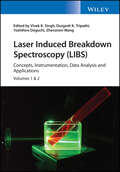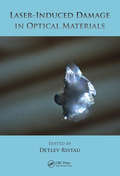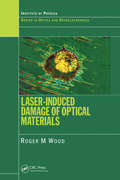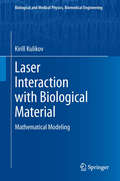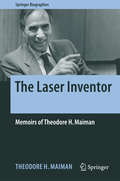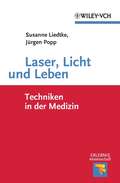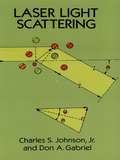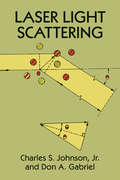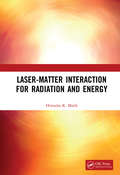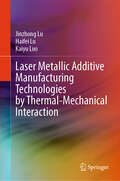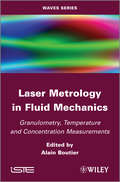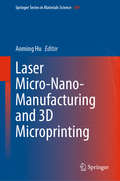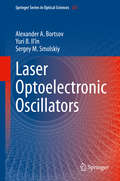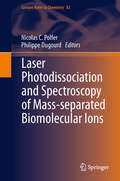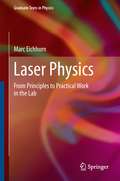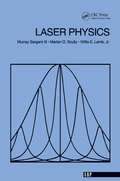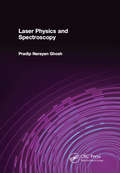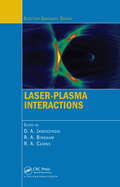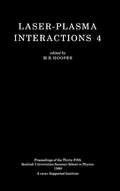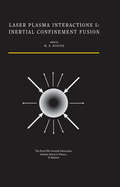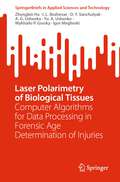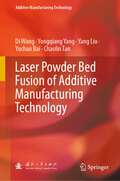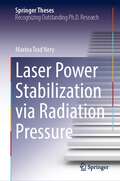- Table View
- List View
Laser Induced Breakdown Spectroscopy (LIBS): Concepts, Instrumentation, Data Analysis and Applications, 2 Volume Set
by Vivek K. Singh Durgesh K. Tripathi Yoshihiro Deguchi Zhenzhen WangLaser Induced Breakdown Spectroscopy (LIBS) Essential resource covering the field of LIBS, with respect to its fundamentals, established and novel applications, and future prospects Laser Induced Breakdown Spectroscopy (LIBS), presents in two comprehensive volumes a thorough discussion of the basic principles of the method, including important recently available data which can lead to a better characterization of the LIBS plasma. This extensive work contains detailed discussions on the lasers, spectrometers, and detectors that can be used for LIBS apparatuses and describes various instrumentation, ranging from basic setups to more advanced configurations. As a modern resource, the work includes the newest advances and capabilities of LIBS instruments, featuring the recent developments of Dual-Pulse LIBS, Femtosecond LIBS, and Micro-LIBS as well as their applications. Throughout, the contributions discuss the analytical capabilities of the method in terms of detection limits, accuracy, and precision of measurements for a variety of samples. Lastly, an extensive range of applications is presented, including food technology, environmental science, nuclear reactors, nanoscience and nanotechnology, and biological and biomedical developments. Sample topics covered within the work include: iagnostics of laser induced plasma (LIP): LIBS plasma and its characteristics, factors affecting the LIBS plasma, methods of enhancing LIBS sensitivity, and LTE/non-LTE plasmas Instrumental developments in LIBS: light collection system and spectral detection systems, handheld LIBS, deep sea LIBS, and industrial sorters and analyzers Femtosecond laser ablation: laser-matter interaction, laser absorption, energy transport, ablation mechanisms and threshold, and plasma characterization Micro-analysis and LIBS imaging: microjoule laser sources, scaling libs to microjoule energies, micrometer scaling, advanced applications, and future prospects Spectroscopic and analytical scientists working with LIBS will find this wide-ranging reference immensely helpful in developing LIBS instrumentation and applications. Researchers and students in natural sciences and related programs of study will be able to use the work to acquire foundational knowledge on the method and learn about cutting-edge advancements being made in the field.
Laser-Induced Damage in Optical Materials
by Detlev RistauDedicated to users and developers of high-powered systems, Laser-Induced Damage in Optical Materials focuses on the research field of laser-induced damage and explores the significant and steady growth of applications for high-power lasers in the academic, industrial, and military arenas. Written by renowned experts in the field, this book concentr
Laser-Induced Damage of Optical Materials (Series In Optics And Optoelectronics Ser.)
by Roger M. WoodThe laser power handling capacities of optical systems are determined by the physical properties of their component materials. At low intensity levels these factors are not important, but an understanding of damage mechanisms is fundamental to good design of laser products operating at high power. Laser Induced Damage of Optical Materials presents
Laser Interaction with Biological Material
by Kirill KulikovThis book covers the principles of laser interaction with biological cells and tissues of varying degrees of organization. The problems of biomedical diagnostics are considered. Scattering of laser irradiation of blood cells is modeled for biological structures (dermis, epidermis, vascular plexus). An analytic theory is provided which is based on solving the wave equation for the electromagnetic field. It allows the accurate analysis of interference effects arising from the partial superposition of scattered waves. Treated topics of mathematical modeling are: optical characterization of biological tissue with large-scale and small-scale inhomogeneities in the layers, heating blood vessel under laser irradiation incident on the outer surface of the skin and thermo-chemical denaturation of biological structures at the example of human skin.
Laser Interaction with Heterogeneous Biological Tissue: Mathematical Modeling (Biological and Medical Physics, Biomedical Engineering)
by Kirill Kulikov Tatiana KoshlanThis book introduces readers to the principles of laser interaction with biological cells and tissues with varying degrees of organization. In addition to considering the problems of biomedical cell diagnostics, and modeling the scattering of laser irradiation of blood cells for biological structures (dermis, epidermis, vascular plexus), it presents an analytic theory based on solving the wave equation for the electromagnetic field. It discusses a range of mathematical modeling topics, including optical characterization of biological tissue with large-scale and small-scale inhomogeneities in the layers; heating blood vessels using laser irradiation on the outer surface of the skin; and thermo-chemical denaturation of biological structures based on the example of human skin. In this second edition, a new electrodynamic model of the interaction of laser radiation with blood cells is presented for the structure of cells and the in vitro prediction of optical properties. The approach developed makes it possible to determine changes in cell size as well as modifications in their internal structures, such as transformation and polymorphism nucleus scattering, which is of interest for cytological studies. The new model is subsequently used to calculate the size distribution function of irregular-shape particles with a variety of forms and structures, which allows a cytological analysis of the observed deviations from normal cells.
The Laser Inventor
by Theodore H. MaimanIn these engaging memoirs of a maverick, Theodore H. Maiman describes the life events leading to his invention of the laser in 1960. Maiman succeeded using his expertise in physics and engineering along with an ingenious and elegant design not anticipated by others. His pink ruby laser produced mankind's first-ever coherent light and has provided transformational technology for commerce, industry, telecom, the Internet, medicine, and all the sciences. Maiman also chronicles the resistance from his employer and the ongoing intrigue by competing researchers in industry and academia seeking to diminish his contribution in inventing the first laser. This work will appeal to a wide readership, from physicists and engineers through science enthusiasts to general readers. The volume includes extensive photos and documentary materials related to Maiman's life and accomplishments never before published. "No one beat Maiman to the laser. How important is the laser? How important are all lasers? That is how important we have to regard Maiman's contribution. He and the laser changed all of our lives, everyone's!" Dr. Nick Holonyak, Jr. , Professor of Electrical and Computer Engineering and Physics, University of Illinois at Champaigne-Urbana, and inventor of the light-emitting diode (LED) and co-inventor of the transistor laser "More than five decades later, we can safely conclude that Theodore Maiman's groundbreaking discovery changed the world. Our modern life just as scientific research would be quite different without the laser. " Dr. Ferenc Krausz, Director, Max Planck Institute for Quantum Optics, Garching, Germany, and Professor of Physics, Ludwig Maximilian University, Munich, and pioneer in attosecond lasers and attophysics "Maiman had the stroke of genius needed to take a different approach [from his competitors]. The sheer elegance and simplicity of his design belies the intellectual achievement it represents. If his invention seems obvious to some today, it was far from obvious in 1960. " Jeff Hecht, authoritative science writer on the historical development of the laser, author of books on lasers and fiber optics
Laser, Licht und Leben: Techniken in der Medizin (Erlebnis Wissenschaft)
by Susanne Liedtke Jürgen PoppDer Mensch hat gelernt, Licht zu kontrollieren, in dem er beobachtete, wie Materie und Licht in der natürlichen Welt sich gegenseitig beeinflussen und verändern. Die neue Disziplin der Biophotonik setzt Licht als vielseitiges Werkzeug ein, um biologische Vorgänge verstehen zu lernen, Krankheiten besser diagnostizieren und heilen zu können. Mit Licht kann man berührungslos messen und Lebensvorgänge im wahrsten Sinne des Wortes 'live' beobachten. Mit Licht kann man aber auch gezielt eingreifen: Pinzetten aus Laserstrahlen halten einzelne Zellen und setzen sie zu künstlichen Geweben zusammen,. Licht kann zudem Schneiden, Bohren, Kleben oder als Katapult dienen. Das Buch gibt kurze Einführungen in die Physik und Chemie des Lichtes und die Grundlagen der Zell- und Molekularbiologie und erzählt die ebenso spannende wie erfolgreiche Geschichte der Zusammenarbeit der beiden Disziplinen im Dienste der Gesundheit des Menschen. Unter dem Motto "Light meets Life Science" eröffnen Biophotoniker im 21. Jahrhundert der Infektionsbiologie, der Krebsforschung und der Gewebezucht völlig neue Möglichkeiten.
Laser Light Scattering: Basic Principles and Practice. Second Edition
by Benjamin ChuGeared toward upper-level undergraduate and graduate students, this text introduces the interdisciplinary area of laser light scattering. It focuses chiefly on quasielastic laser scattering, discussing theoretical concepts at a realistic level.Some background in the physical sciences is assumed, but the opening chapters offer a brief review of classical electricity and magnetism as well as the general scattering theory. Topics include basic theoretical concepts related to light mixing spectroscopy, characteristics of the Fabry-Perot interferometer, and photon-counting fluctuations. The author, a distinguished professor in the Department of Chemistry at Stony Brook University, discusses experimental methods, including setting up a light scattering spectrometer using digital photon-counting and correlation techniques. Subsequent chapters explore applications to macromolecular systems, anemometry and its utility in reaction kinetics, and critical opalescence. References appear throughout the text.
Laser Light Scattering
by Charles S. Johnson Jr. Don A. GabrielLight scattering has provided an important method for characterizing macro-molecules for at least three decades. Now, through the use of intense, coherent laser light and efficient spectrum analyzers and autocorrelators, experiments in the frequency and time domains can be used to study molecular motion, e.g. diffusion and flow and other dynamic processes, as well as the equilibrium properties of solutions. As a result, laser light scattering has become a powerful form of spectroscopy with applications in physics, biochemistry, and other fields. This volume, which employs a relatively simple approach in order to reach the widest audience, focuses on two main topics: classical light scattering (scattering intensity, concentration dependence, size dependence, and polydispersity) and dynamic light scattering (time and frequency dependence, translational diffusion, directed flow, rotational motion, and more). A series of useful appendixes and a list of references complete this concise, accessible work, a valuable resource for physicists, chemists, and anyone interested in the increasingly important field of laser light scattering.
Laser-Matter Interaction for Radiation and Energy
by Hitendra K. MalikThe interaction of high-power lasers with matter can generate Terahertz radiations that efficiently contribute to THz Time-Domain Spectroscopy and also would replace X-rays in medical and security applications. When a short intense laser pulse ionizes a gas, it may produce new frequencies even in VUV to XUV domain. The duration of XUV pulses can be confined down to the isolated attosecond pulse levels, required to study the electronic re-arrangement and ultrafast processes. Another important aspect of laser-matter interaction is the laser thermonuclear fusion control where accelerated particles also find an efficient use. This book provides comprehensive coverage of the most essential topics, including Electromagnetic waves and lasers THz radiation using semiconducting materials / nanostructures / gases / plasmas Surface plasmon resonance THz radiation detection Particle acceleration technologies X-ray lasers High harmonics and attosecond lasers Laser based techniques of thermonuclear fusion Controlled fusion devices including NIF and ITER The book comprises of 11 chapters and every chapter starts with a lucid introduction to the main topic. Then sub-topics are sedulously discussed keeping in mind their basics, methodology, state-of-the-art and future perspective that will prove to be salutary for readers. High quality solved examples are appended to the chapters for their deep understanding and relevant applications. In view of the nature of the topics and their level of discussion, this book is expected to have pre-eminent potential for researchers along with postgraduate and undergraduate students all over the world.
Laser Metallic Additive Manufacturing Technologies by Thermal-Mechanical Interaction
by Jinzhong Lu Haifei Lu Kaiyu LuoThis book introduces the laser hybrid additive manufacturing technology (LHAM) with alternately thermal and mechanical effects for the high-performance manufacturing of key components. Metal additive manufacturing (AM) technologies have made considerable progress in the basic theoretical field since its invention in the 1970s. However, there are still some difficulties in the coordinated control of the structure and performance, containing the challenges of “structure control” against deformation and cracking of the formed metallic components incurred by internal stress and “performance control” against poor fatigue property of formed metallic components incurred by metallurgical defects. This book surveys the most relevant papers about the influence of laser shock wave on the microstructural evolution, residual stress, metallurgical defect, and mechanical properties that have become the foundation to elucidate the principles and effects of LHAM technology. This book is separated into four parts to fully present the LHAM technology. The first part reviews the background of LHAM technology. The second part explains the theoretical basis of the thermal effects of laser additive manufacturing (LAM) and mechanical effects of laser shock peening (LSP). The other two parts specifically describe the microstructural evolution, residual stress, metallurgical defect, and mechanical properties using LHAM technology. This book benefits the audience in the field of mechanical engineering and materials sciences, since LHAM technology is suitable for the manufacturing and applications of the key components of aero-engine. The analysis in the book helps the audience deeply understand the mechanism of LHAM technology. The authors’ unique thinking about LHAM technology also runs through the book, which may enlighten the audience to further develop LHAM technology.
Laser Metrology in Fluid Mechanics: Granulometry, Temperature and Concentration Measurements (Wiley-iste Ser.)
by Alain BoutierIn fluid mechanics, non-intrusive measurements are fundamental in order to improve knowledge of the behavior and main physical phenomena of flows in order to further validate codes.The principles and characteristics of the different techniques available in laser metrology are described in detail in this book.Velocity, temperature and concentration measurements by spectroscopic techniques based on light scattered by molecules are achieved by different techniques: laser-induced fluorescence, coherent anti-Stokes Raman scattering using lasers and parametric sources, and absorption spectroscopy by tunable laser diodes, which are generally better suited for high velocity flows. The size determination of particles by optical means, a technique mainly applied in two-phase flows, is the subject of another chapter, along with a description of the principles of light scattering.For each technique the basic principles are given, as well as optical devices and data processing. A final chapter reminds the reader of the main safety precautions to be taken when using powerful lasers.
Laser Micro-Nano-Manufacturing and 3D Microprinting (Springer Series in Materials Science #309)
by Anming HuThis book provides a comprehensive overview of the latest advances in laser techniques for micro-nano-manufacturing and an in-depth analysis of applications, such as 3D printing and nanojoining. Lasers have gained increasing significance as a precise tool for advanced manufacturing. Written by world leading scientists, the first part of the book presents the fundamentals of laser interaction with materials at the micro- and nanoscale, including multiphoton excitation and nonthermal melting, and allows readers to better understand advanced processing. In the second part, the authors focus on various advanced fabrications, such as laser peening, surface nanoengineering, and plasmonic heating. Finally, case studies are devoted to special applications, such as 3D printing, microfluidics devices, energy devices, and plasmonic and photonic waveguides. This book integrates both theoretical and experimental analysis. The combination of tutorial chapters and concentrated case studies will be critically attractive to undergraduate and graduate students, researchers, and engineers in the relevant fields. Readers will grasp the full picture of the application of laser for micro-nanomanufacturing and 3D printing.
Laser Optoelectronic Oscillators (Springer Series in Optical Sciences #232)
by Alexander A. Bortsov Yuri B. Il’in Sergey M. SmolskiyThis book is devoted to the theoretical and experimental investigation of the optoelectronic oscillator (OEO) with direct and external modulation of laser emission. Such devices, sources of precision radio frequency oscillations using laser excitation, are novel and technologically relevant, with manifold possible applications. The book includes a review of the present state of the theory and generation techniques in microwave and mm-wave ranges for traditional and optoelectronic oscillators, description of OEO construction and operation principles, theoretical oscillation analysis and mathematical description of the relevant semi-classical laser physics, and investigation of the power spectral density of noises. Technical features and advantages of OEOs with external and direct modulation of laser emission are discussed together with functional diagrams. The characteristics of OEOs are compared with other traditional RF oscillators, such as quartz, surface acoustic waves, and oscillators with electromagnetic wave cavities. Special attention is paid to Q-factors and phase noises of RF carriers at small offsets. The authors discuss the technical characteristics of modern optoelectronic methods for precision RF oscillation formation, such as commercial large-dimension and compact quantum frequency standards with optical pumping on cesium and rubidium cells. This book is aimed at scientists and engineers in academia and industry who work with sources of microwave and mm-wave signals.
Laser Photodissociation and Spectroscopy of Mass-separated Biomolecular Ions
by Philippe Dugourd Nicolas C. PolferThis lecture notes book presents how enhanced structural information of biomolecular ions can be obtained from interaction with photons of specific frequency - laser light. The methods described in the book "Laser photodissociation and spectroscopy of mass-separated biomolecular ions" make use of the fact that the discrete energy and fast time scale of photoexcitation can provide more control in ion activation. This activation is the crucial process producing structure-informative product ions that cannot be generated with more conventional heating methods, such as collisional activation. The book describes how the powerful separation capabilities and sensitivity of mass spectrometry (MS) can be combined with the structural insights from spectroscopy by measuring vibrational and electronic spectra of trapped analytes. The implementation of laser-based photodissociation techniques in MS requires basic knowledge of tunable light sources and ion trapping devices. This book introduces the reader to key concepts and approaches in molecular spectroscopy, and the light sources and ion traps employed in such experiments. The power of the methods is demonstrated by spectroscopic interrogation of a range of important biomolecular systems, including peptides, proteins, and saccharides, with laser light in the ultraviolet-visible, and infrared range. The book "Laser photodissociation and spectroscopy of mass-separated biomolecular ions" is an indispensable resource for students and researchers engaged or interested in this emerging field. It provides the solid background of key concepts and technologies for the measurements, discusses state-of-the-art experiments, and provides an outlook on future developments and applications.
Laser Physics
by Marc EichhornThis textbook originates from a lecture course in laser physics at the Karlsruhe School of Optics and Photonics at the Karlsruhe Institute of Technology (KIT). A main goal in the conception of this textbook was to describe the fundamentals of lasers in a uniform and especially lab-oriented notation and formulation as well as many currently well-known laser types, becoming more and more important in the future. It closes a gap between the measureable spectroscopic quantities and the whole theoretical description and modeling. This textbook contains not only the fundamentals and the context of laser physics in a mathematical and methodical approach important for university-level studies. It allows simultaneously, owing to its conception and its modern notation, to directly implement and use the learned matter in the practical lab work. It is presented in a format suitable for everybody who wants not only to understand the fundamentals of lasers but also use modern lasers or even develop and make laser setups. This book tries to limit prerequisite knowledge and fundamental understanding to a minimum and is intended for students in physics, chemistry and mathematics after a bachelor degree, with the intention to create as much joy and interest as seen among the participants of the corresponding lectures. This university textbook describes in its first three chapters the fundamentals of lasers: light-matter interaction, the amplifying laser medium and the laser resonator. In the fourth chapter, pulse generation and related techniques are presented. The fifth chapter gives a closing overview on different laser types gaining importance currently and in the future. It also contains a set of examples on which the theory learned in the first four chapters is applied and extended.
Laser Physics: Proceedings Of The International Conference On Laser Physics And Quantum Optics
by Iii Sargent MurrayThis book treats the interaction of radiation with matter, particular attention being paid to the laser. Knowledge is assumed of the usual half-year introduction of quantum mechanics found in undergraduate physics curricula. The material can be covered in two semesters, or, alternatively, the first part (Chaps 1-13) can be used as a one-semester course in which quantum mechanical aspects of the electromagnetic field are ignored. Each chapter is accompanied by problems that illustrate the text and give useful (occasionally new) results. Existing laser media are intrinsically quantum mechanical and are most easily studied with the quantum theory. Understanding the laser along these lines enlivens one's understanding of quantum mechanics itself. In fact, the material constitutes a viable, applied alternative for the usual second and third semesters of quantum mechanics.
Laser Physics and Spectroscopy
by Pradip Narayan GhoshIn this book emphasis is laid on laser including its operation, different types, properties like coherence and monochromaticity, beam propagation, theoretical treatment of atom‐field interaction, semi‐classical laser theory, non‐linear effects, quantum properties, photon concept and coherent states etc. Please note: Taylor & Francis does not sell or distribute the Hardback in India, Pakistan, Nepal, Bhutan, Bangladesh and Sri Lanka.
Laser-Plasma Interactions (Scottish Graduate Series)
by D. A. Jaroszynski R. Bingham R. A. CairnsA Solid Compendium of Advanced Diagnostic and Simulation ToolsExploring the most exciting and topical areas in this field, Laser-Plasma Interactions focuses on the interaction of intense laser radiation with plasma. After discussing the basic theory of the interaction of intense electromagnetic radiation fields with matter, the book covers three ap
Laser-Plasma Interactions 4 (Scottish Graduate Ser. #35)
by M. B. HooperLaser-Plasma Interactions 4 is the fourth book in a series devoted to the study of laser-plasma interactions. Subjects covered include laser light propagation, instabilities, compression and hydrodynamics, spectroscopy, diagnostics, computer code, dense plasmas, high-power lasers, X-UV sources and lasers, beat waves, and transport processes.
Laser Plasma Interactions 5: Inertial Confinement Fusion: Proceedings of the Forty Fifth Scottish Universities Summer School in Physics, St. Andrews, August 1994
by M. B. HooperThis volume provides a broad overview in the increasingly important field of laser-plasma interactions. With the growth of research into fusion much international effort is being devoted to the problems of inertial confinement. This collection of lectures provides the novice researcher with the context in which current research papers can be understood.Laser Plasma Interactions 5 is one of the first publications to include recently declassified results from the United States inertial confinement fusion research program and as such is an indispensable reference for those wishing to find out about this previously inaccessible research.Presented by 14 speakers of international repute, the emphasis throughout the volume is on inertial confinement fusion. Topics also covered include plasma radiation and transport processes, diagnostic measurements, dense plasmas, high power lasers and X-ray lasers.
Laser-Plasma Interactions and Applications
by David Neely Paul Mckenna Dino Jaroszynski Robert BinghamLaser-Plasma Interactions and Applications covers the fundamental and applied aspects of high power laser-plasma physics. With an internationally renowned team of authors, the book broadens the knowledge of young researchers working in high power laser-plasma science by providing them with a thorough pedagogical grounding in the interaction of laser radiation with matter, laser-plasma accelerators, and inertial confinement fusion. The text is organised such that the theoretical foundations of the subject are discussed first, in Part I. In Part II, topics in the area of high energy density physics are covered. Parts III and IV deal with the applications to inertial confinement fusion and as a driver of particle and radiation sources, respectively. Finally, Part V describes the principle diagnostic, targetry, and computational approaches used in the field. This book is designed to give students a thorough foundation in the fundamental physics of laser-plasma interactions. It will also provide readers with knowledge of the latest research trends and elucidate future exciting challenges in laser-plasma science.
Laser Polarimetry of Biological Tissues: Computer Algorithms for Data Processing in Forensic Age Determination of Injuries (SpringerBriefs in Applied Sciences and Technology)
by Zhengbin Hu I.L. Bezhenar O.Y. Vanchulyak A. G. Ushenko Yu. A. Ushenko Mykhailo P. Gorsky Igor MeglinskiThis book highlights the results of numerical computer-aided smart methods as part of a comprehensive statistical, correlated, and fractal analysis of laser polarimetry. It includes a comprehensive approach to differentiation of lifelong or postmortem origin of injuries and determination of their antiquity based on the analysis of statistical and spatiotemporal frequency evolution of photometric, polarization, and phase parameters of laser images of histological sections of the skin of biomannequins. It discusses the relationship between the coordinate distributions of the intensity of laser images from skin tissues of biomannequins and the nature of its damage. It presents the analysis of relationships between changes in the mean and variance of coordinate distributions of azimuths and ellipticity of polarization images of histological skin sections and the time intervals after injury. Complex differentiation of lifelong and postmortem skin injuries of biomannequins and establishment of their time intervals throughout the entire monitoring interval of changes in the mean and variance of coordinate distributions of phase shifts between orthogonal components of the amplitude of laser images of a series of corresponding histological sections are also presented in this book.
Laser Powder Bed Fusion of Additive Manufacturing Technology (Additive Manufacturing Technology)
by Di Wang Yongqiang Yang Yang Liu Yuchao Bai Chaolin TanThis book systematically introduces the powder bed laser melting technology and its application and summarizes the author's team's experience in scientific research, engineering development, and data accumulation in recent 15 years. It includes in-depth theoretical analysis and a lot of engineering experience in equipment debugging, process development, and material testing. The book takes the powder bed laser melting technology as the object and divides the content into 15 chapters. It is used as technical learning materials for researchers and engineering development personnel engaged in metal 3D printing.
Laser Power Stabilization via Radiation Pressure (Springer Theses)
by Marina Trad NeryThis book offers a comprehensive and complete description of a new scheme to stabilize the power of a laser on a level needed for high precision metrology experiments. The novel aspect of the scheme is sensing power fluctuations via the radiation pressure driven motion they induce on a micro-oscillator mirror. It is shown that the proposed technique can result in higher signals for power fluctuations than what is achieved by a direct power detection, and also that it enables the generation of a strong bright squeezed beam. The book starts with the basics of power stabilization and an overview on the current state of art. Then, detailed theoretical calculations are performed, and the advantages of the new scheme are highlighted. Finally, a proof-of-principle experiment is described and its results are analyzed in details. The success of the work presented here paves a way for achieving high power stability in future experiments and is of interest for high precision metrology experiments, like gravitational wave detectors, and optomechanical experiments.Nominated as an outstanding PhD thesis by the Gravitational Wave International Committee.
